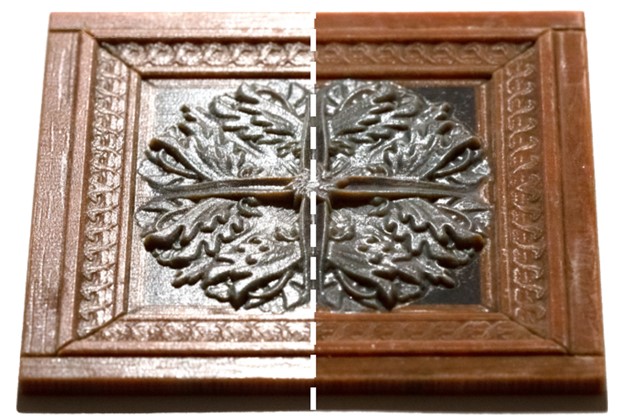3D Printer Enables Simultaneous Surface Glossiness or Matte Variations
Researchers at MIT led by Michael Foshey have solved the challenges of dealing with varying varnish viscosities in 3D printing. To date, 3D hardware has mastered shape and color, but has been slow to deal with the visual feature of “gloss.”
Gloss is a measure of the amount of reflected light from a surface. High-gloss has a mirror finish while low gloss is more like concrete. Currently, creating a contrast between gloss and matte finishes is highly labor-intensive, requiring that an object be printed with high gloss while support structures cover spots that are then are removed to yield surface roughness. It’s either one finish or the other—but not a combination.
In the image above, the left side of this traditional 3D printing doesn’t have varying reflectivity. The right side shows the new improvements so that users can choose which surfaces are glossy and which are matte.
The team developed a combined hardware and software printing system using off-the-shelf varnishes to finish objects for a more realistic, spatially varying gloss pattern. The hardware includes large nozzles with variable pressure and open/closing rates, which allow the printer to adjust to different varnish viscosities. The system also includes software algorithms that create a customized halftoning pattern, comprising a mix of varnishes that reproduces the desired gloss pattern. The viscosity of the varnish used provides the glossy or matte finish.
Matte varnishes are viscous, almost honey-like. This thick consistency is problematic as it can obstruct the clog-prone, skinny fluid channels of a 3-D printer.
To solve this problem, the MIT team created a printer with large nozzles that deposit varnish droplets of varying sizes. Stored in a pressurized reservoir, the varnish is laid down through a needle valve and the speed of its movements and reservoir pressure. The printer achieves halftoning—varnish drops arranged in patterns that from a distance appear to be a continuous surface pattern.
The team also produced a software pipeline to control the printer’s output. Based on the reflectance of calibration patterns, the printer determines optimal halftoning. Results to date are impressive. Potential applications range from fine-art reproduction and the creation of improved prosthetics. Expectations are that the technology’s future integration with commercial 3D printers is possible.
Foshey, a mechanical engineer in the MIT Computer Science and Artificial Intelligence Laboratory (CSAIL), will present the paper at the SIGGRAPH Asia conference, along with lead author Michal Piovarči of the University of Lugano in Switzerland. Co-authors include MIT’s Wojciech Matusik, Vahid Babaei of the Max Planck Institute, Szymon Rusinkiewicz of Princeton University, and Piotr Didyk of the University of Lugano.

